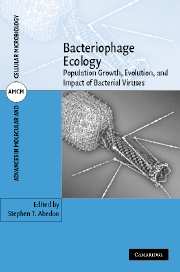Book contents
- Frontmatter
- Contents
- About the cover
- List of contributors
- Foreword by Bruce R. Levin
- Preface
- 1 Phages, ecology, evolution
- Part I Phage ecology
- 2 Bacteriophages: models for exploring basic principles of ecology
- 3 Phage population growth: constraints, games, adaptation
- 4 Impact of spatial structure on phage population growth
- 5 Contribution of lysogeny, pseudolysogeny, and starvation to phage ecology
- Part II Phage evolutionary biology
- Part III Phage ecology in environments
- Part IV Modeling phage ecology
- Index
- Plate section
5 - Contribution of lysogeny, pseudolysogeny, and starvation to phage ecology
from Part I - Phage ecology
Published online by Cambridge University Press: 29 September 2009
- Frontmatter
- Contents
- About the cover
- List of contributors
- Foreword by Bruce R. Levin
- Preface
- 1 Phages, ecology, evolution
- Part I Phage ecology
- 2 Bacteriophages: models for exploring basic principles of ecology
- 3 Phage population growth: constraints, games, adaptation
- 4 Impact of spatial structure on phage population growth
- 5 Contribution of lysogeny, pseudolysogeny, and starvation to phage ecology
- Part II Phage evolutionary biology
- Part III Phage ecology in environments
- Part IV Modeling phage ecology
- Index
- Plate section
Summary
INTRODUCTION
How do bacteriophages exist in the hostile environments that their bacterial hosts inhabit? In most environments, from the desert to the mammalian gut, bacteria live for most of their existence in a starved state (Koch, 1971; Morita, 1997) where energy, carbon, and other resources are in scarce supply. Under such conditions we know that the latency period for phage infection lengthens, that the burst size is greatly reduced (Kokjohn et al., 1991), and that the half-life of virion infectivity (rate of decay) is short (Miller, 2006); yet total counts of virus-like particles present in environmental samples are high. Clearly bacteriophages have evolved strategies for surviving under these unfavorable conditions. As survival-enhancement strategies, many biological entities, from bears to bacteria, have evolved dormant states. During phage infection we recognize analogous dormant states as lysogeny and as pseudolysogeny. In this chapter we explore several aspects of the ecological consequences of these “reductive” infections.
In addition to the material presented here, we direct the reader to additional reviews considering lysogeny, pseudolysogeny, and phage infection of starved bacteria: Barksdale and Arden (1974), Ackermann and DuBow (1987), Schrader et al. (1997a), Robb and Hill (2000), and Miller and Ripp (2002). Related issues, especially of phage contribution to bacterial genotype and phenotype, are also considered in Chapters 11 and 14.
- Type
- Chapter
- Information
- Bacteriophage EcologyPopulation Growth, Evolution, and Impact of Bacterial Viruses, pp. 114 - 144Publisher: Cambridge University PressPrint publication year: 2008
- 31
- Cited by



